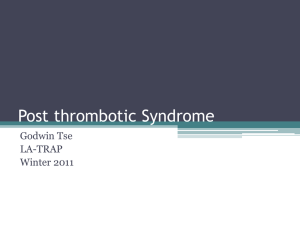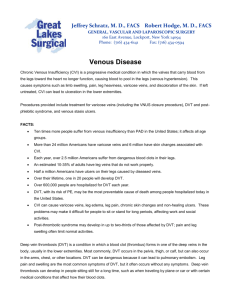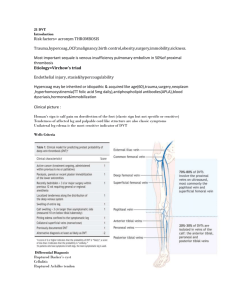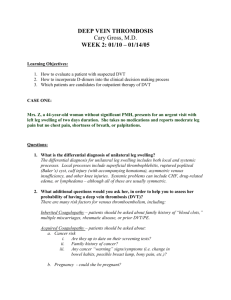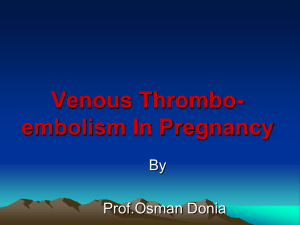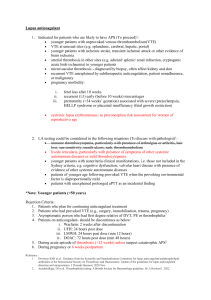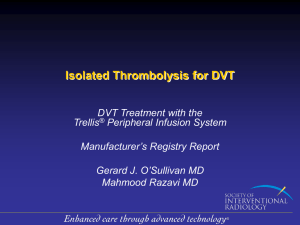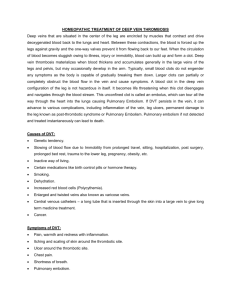DVT: Symptoms and Presentation
advertisement
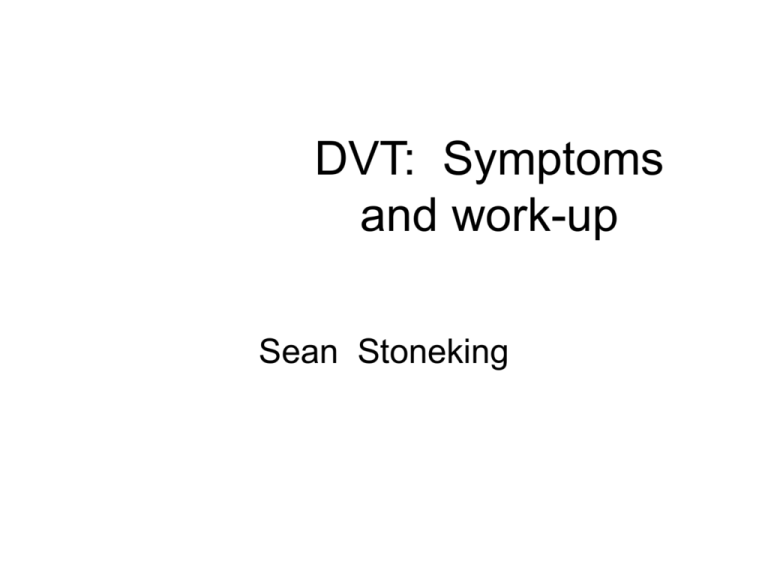
DVT: Symptoms and work-up Sean Stoneking DVT Epidemilogy • Approximately 600,0000 new cases of DVT each year • 50% in hospitalized patients or nursing home residents Clinical Signs and Symptoms • • • • • • • Up to 50% are asymptomatic Pain Edema Warmth Discoloration Palpable cord of a thrombosed vein Homan’s sign (present 1/3 of cases) DDx of acute edema/leg pain? • Infection • Trauma/injury • Venous insufficiency Risk Factors: Virchow’s Triad • Stasis • Venous endothelial injury • Hypercoagulable state Risk factors • • • • • • • • • • Past DVT Immobilization Pregnancy OCP and HRT Trauma Obesity Age Sepsis Cancer Diseases that alter blood viscosity (sickle cell, polycythemia, multiple myeloma) Risk Factors: Thrombophilias • Anticoagulant protein deficiency (Protein C/S, Antithrombin Plasminogen, Heparin cofactor II) • Dysfibrinogenemia • Antiphospholipid antibodies • Factor V Leiden mutation (heterozygous) • Prothrombin G20210A mutation (heterozygous) Wells pretest probability Clinical features Points 1. Active cancer (treatment within 6 months) 1 2. Paralysis, paresis, or immobilization of lower extremity 3. Bedridden for more than 3 days because of surgery 1 (within 4 weeks) 4. Localized tenderness along distribution of deep veins 5. Entire leg swollen 1 6. Unilateral calf swelling of greater than 3 cm (below 1 tibial tuberosity) 7. Unilateral pitting edema 8. Collateral superficial veins 1 9. Alternative diagnosis as likely as or more likely than 1 DVT 1 1 -2 Pretest Probability Interpretation • >=3 points: high risk (75%) • 1 to 2 points: moderate risk (17%) • <1 point: low risk (3%). Ramzi and Leeper, Am Fam Phys 2004;69 (12). Testing Modalities • • • • • Ulrasonography D-dimers Contrast venography MRI Spiral CT Ultrasound • In the proximal veins sensitivity is 97% • In the calf veins sensitivity is only 73% • It cannot distinguish between an old clot and a new clot. D-dimers • Degradation product of a cross-linked fibrin blood clot. • Levels also elevated in recent major surgery, hemorrhage, trauma, pregnancy or cancer. • Sensitive but nonspecific • The value is in a negative test result Contrast venography • • • • “Gold Standard” for imaging DVT can image entire lower extremities Sensitive in asymptomatic patients Limitations: invasive, contrast reactions MRI • Good test for suspected iliac vein or inferior vena caval thrombosis • More sensitive than any other noninvasive study in suspected calf vein thrombosis. • Expense, lack of general availability Spiral CT • When PE is suspected, can scan chest and lower extremities with same amount of contrast. • ~50% more costly than ultrasound • Risk of contrast reaction Summary • Use risk stratification of H&P with diagnostic testing to make the diagnosis • Up to 50% of pts with DVT are asymptomatic • Negative D-dimer rules out DVT in low probability • Ultrasound useful for diagnosing proximal thromboses • MRI and contrast venography useful for diganosing distal thromboses

